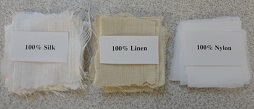
March 17, 2016
In our thermal conductivity perspectives series, we have enjoyed presenting topics that challenge you to assess how thermal conductivity, a factor that many people rarely think of, affects so much in our every day lives. Next time that you are looking in your closet, take a moment to study the clothes in front of you. Why did decide to purchase each item? Believe it or not, thermal conductivity is a major factor when it comes to determining the comfort of our clothing. Without realizing it, many items in your closet were most likely chosen because they had desirable thermal characteristics. Your winter jackets and thick sweaters were picked because they felt warm, your workout clothes chosen because they prevent you from overheating while exercising, and your summer t-shirts selected because they felt cool and allow some air flow on those hot summer days.

The ideal thermal characteristics of a piece of clothing depend on what you want to use it for! 1
Thermal conductivity is incredibly important to clothing manufacturers, because the comfort that it imports and the characteristics that it lends to the clothing item will determine whether that piece of clothing will be comfortable for us to wear. Clothing made out of materials with low thermal conductivities are excellent choices for cold weather, since they do not readily transport our body heat to the environment and therefore help to keep us warm! However, if you are heading out for a run, a t-shirt produced from a fabric with a high thermal conductivity will help to keep you cool, as it will quickly remove the heat you produce away from your body.
Thermal conductivity influences more than just whether our clothes will help us stay warm or cool, it also affects how the clothes will feel. Have you noticed that some fabrics feel warm to the touch, while others feel much cooler? Thermal conductivity is a factor behind that difference. Fabrics with higher thermal conductivities feel much cooler, while those with low thermal conductivities feel much warmer.
Here at Thermtest, we set out to test the thermal conductivity of three fabrics to see the range of thermal conductivities that exist between fabrics for ourselves. In our lab, one of our scientists measured the thermal conductivity of 100% linen, nylon, and silk using TPS thermal constants analyzer. Identically sized squares were cut from the sample pieces, and several were placed on either side of the sensor. Each fabric was tested five times, and the average thermal conductivity value was calculated.

The fabrics in the Thermtest lab ready for testing.
The results revealed that these three fabrics have very different thermal conductivity values (Table 1). Silk had the lowest thermal conductivity at 0.083 W/mK, while linen had the highest thermal conductivity of 0.188 W/mK. Therefore, on a hot summer day, you will be much more comfortable in a linen shirt than you would be in silk shirt. However, of the three fabrics tested, silk would do the best job at keeping you warm on a cool day.
| Fabric | Thermal Conductivity (W/mK) |
| 100% Linen | 0.188 |
| 100% Silk | 0.083 |
| 100 % Nylon | 0.129 |
One last thing to keep in mind is that the material making up the clothing itself is not the only factor influencing the thermal conductivity, how the garment is made will also have an impact. Have you ever wondered why a bulky homemade knitted sweater is so much warmer than the store bought woven one, even though they are made from the same material? It is due to the amount of air trapped in the fabric. Air has a very low thermal conductivity, therefore the air trapped in the knitted sweater also helps to keep you warm. The next time you are out shopping, remember how thermal conductivity can determine the comfort of your clothes, and choose wisely!
Sources
Abitha, M., Roshanara, Subramaniam, V. 2015. Thermal Conductivity of Fabrics. Applied Mechanics and Materials. 813-814: 768-772.
Frydrych, I., Dziworska, G., Bilska, J. 2002. Comparative Analysis of the Thermal Insulation Properties of Fabrics Made of Natural and Man-Made Cellulose Fibres. Fibres and Textiles of Eastern Europe. October/December: 40-44.
Photo References:
1- http://www.camping-soelden.com/en/mainmenu/winter/sports-fun.html